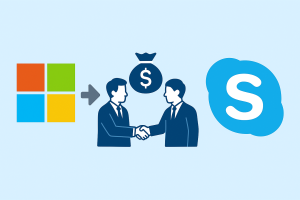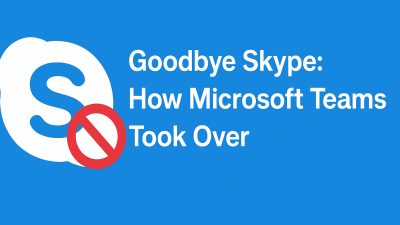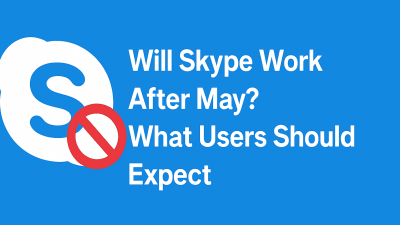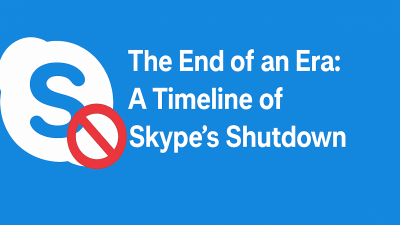Before we dive into Skype’s story, it helps to remember what the internet was like back in 2003. This was pre-iPhone. Pre-YouTube. Facebook didn’t exist yet. Most people were still using email for communication, and phone calls, especially international ones, were expensive and often unreliable.
And then along came Skype.
It didn’t launch with a splashy ad campaign or celebrity endorsement. It was just… suddenly there. A downloadable app that let you talk to anyone in the world for free as long as both of you had internet access.
For a lot of people, Skype wasn’t just a convenience. It was a breakthrough. It felt almost too good to be true. And it changed how millions of people communicated across borders.
The Founders and the First Call (2003–2005)
Skype was created by a small team of developers from Estonia and Scandinavia — the same folks behind file-sharing service Kazaa. They weren’t trying to build a corporate enterprise tool. Their goal was simple: make voice communication over the internet as easy and natural as picking up a phone.
And it worked. By late 2004, Skype had millions of users.
What made it special?
-
You didn’t need a landline.
-
It worked on slow internet connections.
-
It was free.
-
It just worked.
You could talk for hours. See people’s faces across continents. Parents spoke to their children studying abroad. Freelancers landed clients across time zones. Suddenly, geography wasn’t a barrier anymore.
That kind of impact spreads fast.
The eBay Years (2005–2009): The First Big Buyout
In 2005, eBay bought Skype for $2.6 billion. At the time, it was one of the biggest tech acquisitions ever.
But here’s where things started to get complicated.
eBay was focused on commerce — selling, buying, bidding — and they thought Skype might help users communicate better around transactions. The problem? Skype wasn’t built for that. It was never about negotiating auction deals. It was about connection.
So while the user base kept growing, Skype’s development slowed down. Features didn’t evolve. The product stayed more or less the same, while the rest of the internet was speeding up around it.
By 2009, eBay realized Skype didn’t fit into their business model. They sold most of their stake to a private investor group. And that’s when Microsoft entered the picture.
Microsoft Acquires Skype (2011): A Big Bet on Communication

In 2011, Microsoft bought Skype for $8.5 billion, nearly triple what eBay paid.
It was a bold move.
Microsoft saw Skype as the future of communication: voice, video, messaging, all under one roof. At the time, they were trying to modernize their software lineup and compete with emerging platforms.
A few things changed quickly:
-
Skype replaced Windows Live Messenger, Microsoft’s older chat tool.
-
It was integrated into Outlook, Xbox, and later into Office.
-
Microsoft began exploring both consumer and enterprise use cases.
For a while, it worked. Skype had brand recognition. It was still widely used. And Microsoft had the scale to support it globally.
But while Skype was steady, it wasn’t evolving.
Skype’s Golden Years (2011–2015): Familiar, but Frozen
If you used Skype during these years, it likely felt like a staple — a tool you could count on, even if it wasn’t exciting.
Millions of people used it to:
-
Interview for remote jobs
-
Call family overseas
-
Host group chats or video meetups
-
Share screens for client meetings
The features weren’t flashy, but they were functional. Skype did one thing well: it connected people.
But under the surface, the cracks were forming.
What started going wrong?
-
The mobile app was clunky and laggy compared to newer competitors.
-
Updates were inconsistent — some versions worked better than others.
-
The user interface didn’t modernize, especially for younger users used to slick, mobile-first apps.
-
Skype started feeling… out of step with the rest of the digital world.
Meanwhile, other tools were learning from Skype and moving faster.
A Quiet Plateau
By 2015, Skype was still a major name, but no longer a market leader in innovation.
Younger users were turning to WhatsApp, Facebook Messenger, FaceTime, and newer tools like Zoom. Skype remained familiar but not exciting. Reliable but not flexible.
And Microsoft, behind the scenes, was starting to plan something else. Something built from the ground up for a new kind of communication: structured, collaborative, and designed to scale.
That “something else” was Microsoft Teams.
From Familiar to Forgettable: Skype’s Grip Starts to Slip (2016–2018)
By the mid-2010s, Skype had already reached its peak. It was still widely used by businesses, families, and anyone needing reliable video calls — but something had changed. People weren’t talking about Skype the same way anymore.
It wasn’t about dislike. It was about indifference.
Apps like WhatsApp, FaceTime, and Google Duo made casual video calls easier. Slack was gaining momentum in workplaces. And Zoom — still in its early days — was quietly building a product that would eventually eat everyone’s lunch in the remote meeting space.
Meanwhile, Skype wasn’t doing much to reinvent itself.
The interface still felt dated. The performance on mobile devices wasn’t consistent. And the user experience hadn’t evolved for people who now expected real-time chat, fluid file sharing, and fast, simple video with no setup required.
Skype was still useful, but it didn’t feel modern anymore.
The Skype for Business Move (and the Confusion It Created)

In 2015, Microsoft tried something new: they split Skype into two products.
-
Skype (Consumer version) — for personal use
-
Skype for Business — built into Office 365 for enterprise communication
The idea made sense on paper. But in practice, it confused people.
Were they supposed to switch? Which app did they need? Could you use both?
The branding overlap caused friction. Features weren’t always consistent across the two versions. And support documentation often blurred the lines between them.
Internally, Microsoft was already working on a much bigger shift: building a new communication platform from the ground up. One that would eventually absorb both Skype and Skype for Business.
It was called Microsoft Teams, and it was just getting started.
The Birth of Microsoft Teams (2017): A New Direction Emerges
When Microsoft officially launched Teams in 2017, it was framed as a Slack competitor — something designed for businesses, not individuals.
It offered persistent chat rooms (“channels”), file sharing, app integrations, and scheduled meetings. At first, Teams didn’t seem like a threat to Skype — they looked like different tools for different use cases.
But behind the scenes, Microsoft was starting to shift its strategy.
They had learned from Skype’s limitations:
-
Skype wasn’t built for group collaboration
-
It didn’t scale easily for hybrid teams
-
It lacked structure for ongoing, multi-threaded conversations
Teams, on the other hand, could be built for that from day one. So Microsoft did what a lot of companies do quietly: they stopped innovating on the old platform and started pouring everything into the new one.
Updates for Skype slowed down. User complaints went unresolved. Teams got cleaner, faster, and more visible with every release.
2020: The Pandemic Hits — and Skype Misses Its Moment
When COVID-19 hit, the world went remote overnight. Everyone scrambled for tools to work, learn, and connect from home.
Zoom exploded in popularity.
Google Meet got a revamp and rolled out for free users.
Even FaceTime saw a spike in usage.
So… what happened to Skype?
Here’s the strange part: it should have been Skype’s comeback moment. It had brand recognition. It was already built for video calling. It had a huge user base.
But instead, Skype stayed quiet. Teams became Microsoft’s priority. And Skype, which once led the pack, fell further behind — not because it couldn’t compete, but because Microsoft had already moved on.
Teams became the new face of Microsoft’s communication strategy, both for work and, increasingly, for personal use. They added a free version. They simplified the interface. They made it available on mobile. Skype was still there, but it was no longer the focus.
The Phase-Out Period (2021–2024): A Silent Exit
After the pandemic rush, Microsoft made it clear — not with a splashy announcement, but with small, quiet moves.
-
Skype for Business was officially retired in 2021.
-
Teams gained all major calling and messaging features.
-
Skype updates slowed to a near halt.
-
Skype branding was removed from new Office products.
Users started noticing. Support channels became slower. The website stopped highlighting new features. The app was still functional, but it felt like a ghost town.
By late 2023, it was clear: Skype wasn’t part of Microsoft’s future anymore. The company was sunsetting the product quietly, giving users time to move on without making a scene.
Then, in early 2025, the official word came.
February 2025: The Shutdown Announcement
On February 28, 2025, Microsoft posted a notice on their official blog:
Skype will be retired on May 5, 2025.
They finally said it out loud — and gave users just over two months to prepare. In the post, Microsoft confirmed:
-
Skype would no longer work after the shutdown date
-
Skype Credit and subscriptions would expire
-
Users could migrate to Microsoft Teams using their existing login
-
Chat history and contacts could be accessed temporarily (with manual export)
It wasn’t shocking for those who had been watching closely. But for casual users — especially people who hadn’t checked Skype in a while — it felt abrupt.
Skype had once been everywhere. Now it was officially logging off.
The Legacy of Skype: What It Left Behind
Skype didn’t fail. It changed everything, and then the world kept changing.
It introduced millions of people to video calling for the first time. It made long-distance relationships easier. It helped small businesses go global. It brought voices and faces together in a way that felt new and human.
Skype helped define the internet era where people talked, not typed.
Even if it didn’t keep up with the competition, its legacy is solid:
-
It paved the way for Teams, Zoom, and every video tool that came after.
-
It normalized free, global communication.
-
It proved that distance doesn’t have to be a barrier.
Now it’s stepping aside. Not with a crash, but with a quiet handoff from a pioneer to the platforms it inspired.
Final Word
If Skype meant something to you whether it was a call home from college, a virtual meeting in a new job, or a friend you stayed close to through video, it’s okay to feel a little nostalgic.
It’s not just an app shutting down. It’s the end of a chapter in how we connect online.
But every chapter leads to the next one.
And for Microsoft, that next chapter is Teams.
💬 Frequently Asked Questions
1. When was Skype first launched?
Skype was launched in 2003 by a group of developers from Estonia and Scandinavia. It quickly became a pioneer in internet-based calling.
2. Why did Microsoft buy Skype in 2011?
Microsoft acquired Skype for $8.5 billion to strengthen its communication tools and eventually replace Windows Live Messenger with a more modern platform.
3. What was Skype for Business, and how was it different?
Skype for Business was a separate product launched in 2015 for corporate users, integrated into Office 365. It caused confusion due to overlap with the regular Skype app and was officially retired in 2021.
4. When did Microsoft launch Teams, and why did it replace Skype?
Microsoft Teams launched in 2017 as a collaboration tool initially aimed at business users. Over time, it evolved to include personal use and gradually replaced Skype due to its advanced features and scalability.
5. Did Skype get a boost during the COVID-19 pandemic?
Surprisingly, no. While video communication surged globally, Skype failed to capitalize on the moment. Apps like Zoom and Teams gained more attention and user growth.
6. What was the official announcement date of Skype’s shutdown?
Microsoft officially announced Skype’s retirement on February 28, 2025, with a final shutdown date of May 5, 2025.
7. What led to Skype’s decline in popularity?
Skype’s decline came from a mix of slow development, poor mobile performance, increased competition, and Microsoft shifting focus to Teams.
8. Is Microsoft building a new communication app to replace Skype?
No. Microsoft is encouraging all users to transition to Microsoft Teams, which now offers a free version for personal and casual use.




